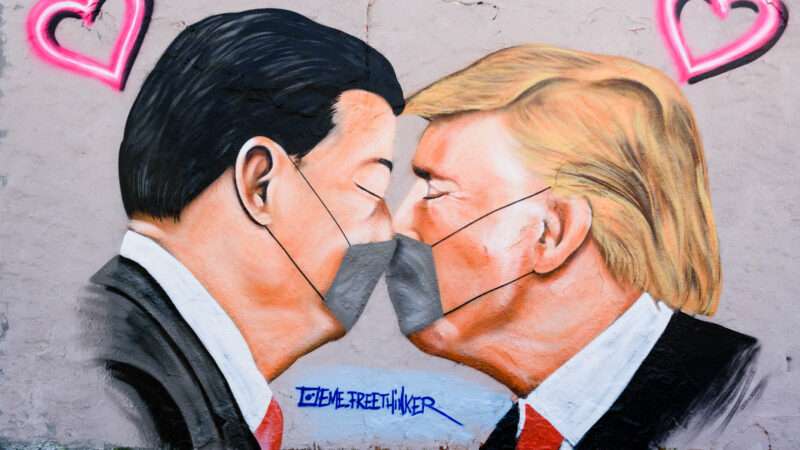
Managed trade has failed once again.
The so-called “phase one” trade deal inked in December 2019 by former President Donald Trump and Chinese President Xi Jinping might have put an end to the spiraling trade war between the two countries, but the agreement did not result in China buying more American goods, as both leaders promised it would. In fact, during the two years covered by the deal, China imported fewer American goods than before the trade war began—meaning that the deal did not even succeed at patching up the damage caused by Trump’s bellicose trade policies.
“After two years of escalating tariffs and rhetoric about economic decoupling, the deal did little to reduce the uncertainty discouraging the business investment needed to restart U.S. exports,” writes Chad Bown, a senior fellow at the Peterson Institute for International Economics, a pro-trade think tank.
For two years, Bown has been tracking the promises made by both countries in what Trump called the “phase one” deal—there never was a phase two—as it has become increasingly apparent that those goals would not be met. In his final analysis of the two-year agreement, which expired on December 31, Bown concludes that “China bought only 57 percent” of what it had promised, not even enough to reach pre-trade-war levels.
As part of the deal, China agreed to increase its purchases of American-made goods by at least $200 billion over 2017 levels (that is, pre-trade-war levels) by the end of 2021. Those increased purchases were supposed to be spread across multiple sectors of the American export economy, something Trump promised would provide much-needed relief to farmers, manufacturers, and other businesses harmed by the tariffs he’d imposed since taking office.
But there were signs right from the start that the export promises were unrealistic; more about Trump’s domestic re-election campaign than a serious concession from China. As The Wall Street Journal noted shortly after the deal was made public, Trump was effectively asking for “an unprecedented jump in bilateral trade.” To meet its obligations, China would have to hike its purchases of U.S. goods by 60 percent over the pre–trade-war baseline. It is unsurprising that this fundamentally unserious and politically motivated arrangement never delivered on its promise.
The real problem with Trump’s “phase one” trade deal, however, had little to do with the specific dollar amounts attached to the purchasing promises. By demanding that China buy more goods from the U.S.—as if the two countries were actually large corporations doing business with one another, not a collection of people and businesses who actually do trade with one another—Trump was actually making huge concessions to the Chinese regime.
“The purchase commitments undermine U.S. global economic leadership and risk the U.S. ceding the high ground on the preeminence of its economic model,” wrote Joshua Meltzer and Neena Shenai, researchers for the Brookings Institution, in 2020. “In fact, they betray long-standing core principles espoused by the U.S. such as free markets and the rule of law, and, in the process, affirm and elevate the Chinese state-led and controlled dirigiste model of economic growth and trade.”
“With its demand that the Chinese government fulfill what are in effect quotas on purchases of U.S. goods and services, the Trump administration is only reinforcing the sway of the hardliners in Beijing at the expense of more pro-market reformers,” warned Dan Griswold, a senior research fellow at the Mercatus Center, a free market think tank, in December 2019. “All for a promise of more exports that may or may not ultimately materialize.”
We now know that the promised benefits did not materialize. But the costs certainly keep adding up. Auto manufacturers, for example, shifted supply chains to avoid the cost of tariffs and economic uncertainty created by the trade war—by relocating some American manufacturing jobs to China, which has become a large and growing market for auto sales. BMW, for example, shifted much of the production of its X3 sport-utility vehicle from Spartanburg, South Carolina, to China after reporting that tariffs had cut the company’s American profits by about $338 million in 2018. The higher costs imposed by the trade war caused Tesla to announce that it was “accelerating construction” of a new plant in Shanghai.
Overall, Bown estimates, exports to China would have been $26 billion higher in 2020 and $39 billion higher in 2021 if not for the impact of the trade war and subsequent trade deal. That doesn’t account for other losses sustained during the trade war, like the increased farm subsidies paid for by American taxpayers and the run-of-the-mill cost increases created by tariffs.
Aside from some positive developments with regard to China’s treatment of intellectual property and financial services, probably the only good thing about Trump’s “phase one” trade deal is that it has now expired.
“President Trump’s trade war and phase one agreement did little to change China’s economic policymaking,” Bown concludes. “Beijing seems intent on becoming more state-centered and less market oriented.”
The post Trump's Trade Deal With China Was an Abject Failure, Just Like the Trade War appeared first on Reason.com.
from Latest https://ift.tt/SZlXv5F
via IFTTT